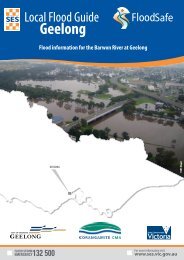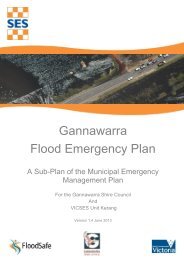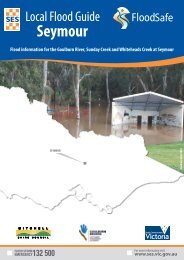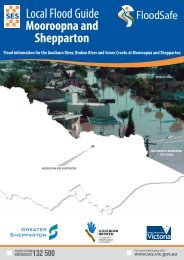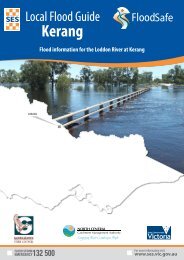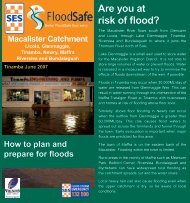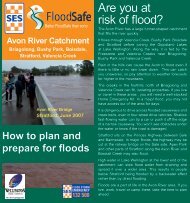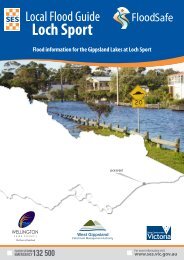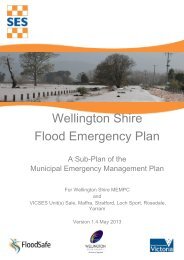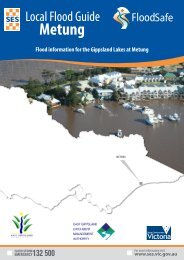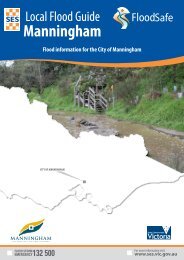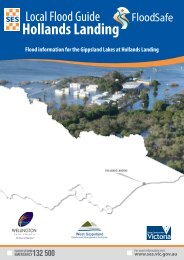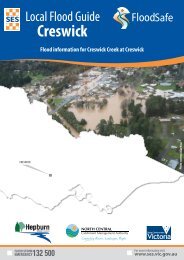Eagle Point Local Flood Guide.pdf - Victoria State Emergency Service
Eagle Point Local Flood Guide.pdf - Victoria State Emergency Service
Eagle Point Local Flood Guide.pdf - Victoria State Emergency Service
- No tags were found...
Create successful ePaper yourself
Turn your PDF publications into a flip-book with our unique Google optimized e-Paper software.
<strong>Local</strong> <strong>Flood</strong> <strong>Guide</strong><strong>Eagle</strong> <strong>Point</strong>Safe<strong>Flood</strong> information for the Gippsland Lakes at <strong>Eagle</strong> <strong>Point</strong>EAGLE POINTEAST GIPPSLANDCATCHMENTMANAGEMENTAUTHORITY
Preparing for <strong>Flood</strong>sNOW – before a flood■■ Check if your home or business is subject to flooding. Formore information, contact East Gippsland Shire.■■Develop an emergency plan.■■Check if you could be cut off by floodwater.■■Know the safest way to go if you decide to leave yourproperty and plan an alternative route.■■Check your insurance policies to ensure your equipment,property and business are covered for flood damage.■■Keep a list of emergency numbers near the telephone.■■Put together an emergency kit.■■Stay alert for weather warnings and heavy rainfall.When a flood is likely■■■■■ Take action. Follow your emergency plan.■ Listen to your radio for information and advice.■ Check your neighbours are safe and know about the flood.■ Stack possessions on benches and tables with electricalgoods in the highest places.■■Anchor objects that are likely to float and cause damage.■■Move rubbish bins, chemicals and poisons to the highestplace.■■Put important papers, valuables, photos and other specialpersonal items into your emergency kit.■■Business owners should raise stock, business records andequipment onto benches and tables.■■Rural property owners should move livestock, pumps andmachinery to higher ground.■■If you are likely to be isolated, have enough food, drinkingwater, medicine, fuel and other needs to last at least threedays.■■Do not forget pet food and stock feed.The time for me to evacuate is before:Your emergency planEmergencies can happen at any time, with little warning.People who plan and prepare for emergencies reduce the impactand recover faster.Taking the time to think about emergencies and make your ownplan helps you think clearly and have more control to make betterdecisions when an emergency occurs.Your emergency plan should identify:■■The types of emergencies that might affect you.■■How those emergencies might affect you.■■What you will do before, during and after an emergency.■■Where to get more information.■■Where you will go if you evacuate and the best way to go indifferent circumstances.■■A list of phone numbers you will need, including emergencyservice providers, your insurance company, friends and family.Visit ses.vic.gov.au to obtain a copy of your Home<strong>Emergency</strong> Plan workbookEvacuationPrepare a planDuring a flood, Police, SES and other emergency service providersmay advise you to evacuate to keep you safe. It is important thatyou follow this advice.Preparing For <strong>Flood</strong>sThere are two types of evacuation notices that may be issued viayour emergency broadcaster during a flood:■■Prepare to evacuate – means you should act quickly andtake immediate action to protect your life and property. Beready to leave your property.■■Evacuate immediately – you must leave immediately asthere is a risk to lives. You may only have minutes to evacuatein a flash flooding situation.Do not return to your home until you are sure it is safe to do so.You do not need to wait to be told to evacuate.<strong>Local</strong> <strong>Flood</strong> <strong>Guide</strong> 5
Home <strong>Emergency</strong> Kit<strong>Emergency</strong> KitEvery home and business should have a basic emergency kit:Copy of your emergency planRadio Torch Spare batteries Copy of documents & recordsLong life foodFirst aid kitSafe drinking waterGlovesCheck your kit often. Make sure things work. Replace out of date items.When a warning is issued, have ready for use or pack into your kit:Mobile phone and charger Prescriptions & medicines Pet needs Strong shoes Clothes for your family3 days supply3 days supply3 days supply3 days supplyI need to add:Write your list here. Tick items as you pack them into your kit.Special needsPhotosFamily keepsakesValuablesDocumentsOther6<strong>Local</strong> <strong>Flood</strong> <strong>Guide</strong><strong>Local</strong> <strong>Flood</strong> <strong>Guide</strong>
During and After a <strong>Flood</strong>During a floodWhen flooding has begun:■■Never drive, ride, swim or walk through floodwater.■■ Remember that floodwater can be deeper than you think andcan hide damaged roads and bridges.■■Never let your children play or swim in floodwater.It is dirty, dangerous and deadly.■■Tune in to your emergency broadcasters: ABC <strong>Local</strong> Radio,Commercial Radio, designated Community Radio Stationsand SKY NEWS Television.■■In life-threatening emergencies, call Triple Zero (000).■■For SES emergency assistance during floods and storms call132 500.■■Stay away from all waterways including drains and culverts.■■Stay away from fallen powerlines as electricity travels easilythrough water.■■Be aware that animals such as snakes, rats, spiders and otherpests may be on the move during a flood. These animalscan come into houses and other buildings or hide aroundsandbags.■■Keep in contact with neighbours.■■Be prepared to leave early.When you leave early or evacuate:■■Try to leave as early as possible as roads can be closed byfloodwater.■■ Take your emergency kit and three days supply of clothingwith you.■■Turn off the electricity, gas and water as you leave.■■Take your pets with you. Dogs should be muzzled and cats incages.■■Go to a Relief Centre or to stay with friends or family in a nonflooded area.If activated, Relief Centres can provide:■■Temporary accommodation■■Financial help■■Personal support■■Drinks and meals■■■ Basic clothing and personal needs■ Assistance with contacting family and friends.After a flood<strong>Flood</strong> dangers do not end when the water begins to fall. To makesure you stay safe:■■Keep listening to local emergency broadcasters.■■ Do not return home until you are sure that it is safe.Once you return to your home:■■Investigate the structural safety of your building.■■Drink bottled water or boil all drinking water until advisedthat the water supply is safe.■■Throw away any food or medicines that may have been incontact with floodwater or affected by power outages.■■When entering a building, use a torch to light yourway. Never use matches or cigarette lighters as there may begas inside.■■Keep the electricity and gas off until checked and tested by aprofessional.■■Take photographs of all damage for insurance.■■Clean your home straight away to prevent disease.How SES helps the communityThe <strong>Victoria</strong> <strong>State</strong> <strong>Emergency</strong> <strong>Service</strong> (SES) is a volunteer basedemergency service. Although SES volunteers attempt to reacheveryone prior to or during an emergency, at times this is notpossible, especially during flash flooding which occurs so quickly.Therefore it is advisable for you to be prepared for emergencies sothat you can share responsibility for your own wellbeing duringthose times. In a flood, SES assistance may include:■■Giving flood advice■■Protecting essential services■■Helping to protect infrastructure■■Rescuing people from floodwater■■Advising of an evacuationTo assist your preparation, it is recommended that you obtain acopy of the SES Home <strong>Emergency</strong> Plan by visitingses.vic.gov.au.During and After a <strong>Flood</strong>If you choose to shelter with a friend or relative, tell authoritieswhere you are staying.<strong>Local</strong><strong>Local</strong><strong>Flood</strong><strong>Flood</strong><strong>Guide</strong><strong>Guide</strong> 7 7
Checklist and Contacts<strong>Emergency</strong> ChecklistNOW: <strong>Flood</strong> preparation■■Check if your insurance policy cover flooding.■■■ Keep this list of emergency numbers near the telephone.■ Put together an emergency kit and prepare a home or businessemergency plan, see ses.vic.gov.au.When you hear a <strong>Flood</strong> Watch or weather warning■ ■ Listen to Severe Weather Warnings for flash flood.■■ Listen to the radio and check the SES website for moreinformation and advice.■ ■ Go over your emergency plan. Pack clothing and other extraitems into your emergency kit and take this with you if youevacuate.■ ■ Leave early if you intend to evacuate.When flooding may happen soon (heavy rainfall)■■Make sure your family members and neighbours are aware ofwhat is happening.■■Conditions change rapidly, roads and escape routes canbe covered or blocked. Don’t forget to take pets and yourmedicine with you.■■Put household valuables and electrical items as high aspossible.■■Turn off water, gas and electricity at the mains.■■Secure objects likely to float and cause damage.■■If you are staying in a caravan or temporary dwelling, move tohigher ground before flooding begins.During the flood■■For SES emergency assistance, call 132 500.■■ Do not drive, ride, swim or walk through floodwater. This isthe main cause of death during floods.■■NEVER allow children to play in floodwater. This is the maincause of death during floods for children and young people.■■Stay away from drains, culverts and waterways as water canflow quickly and have strong currents.■■Stay well clear of fallen trees, powerlines and damagedbuildings.After the flood: recovery■■If your property has been flooded, check with East GippslandShire for information and advice.■■Have all electrical and gas equipment professionally testedbefore use.For more information visit:ses.vic.gov.aufacebook.com/vicsestwitter.com/vicseswarnings<strong>Emergency</strong> ContactsLife-threatening emergencyPolice Fire Ambulance<strong>Victoria</strong> <strong>State</strong> <strong>Emergency</strong> <strong>Service</strong> (SES)For SES emergency assistanceSES Information LineOperates during major floods or stormsBureau of Meteorology (BoM)Weather information, forecasts, warningsNational Relay <strong>Service</strong> (NRS)Internet Relay users log intoVicRoadsRoad closures and hazard reporting service132 500Triple ZeroTTY1061300 842 7371300 VIC SESses.vic.gov.au1300 659 217bom.gov.auwww.relayservice.com.auThe deaf, hearing or speech impaired can call SES or Triple Zero (000) using NRS:■■■■Speak and Listen (SSR) users phoneTTY / Voice users phone<strong>Emergency</strong> Broadcasters<strong>Emergency</strong> broadcasters include ABC<strong>Local</strong> Radio, designated commercial radiostations across <strong>Victoria</strong> and SKY NEWSTelevision.Your electricity supplier:Your gas supplier:Doctor:Vet:InsurancePolicy Number:Phone Number:000Dial1300 555 72713 36 77www.iprelay.com.au/call/then enter: 132 500 or 00013 11 70vicroads.vic.gov.auEast Gippsland Shire Contact DetailsPhone: 1300 555 886Email:feedback@egipps.vic.gov.auWeb:www.eastgippsland.vic.gov.auWeather District:Catchment:East GippslandGippsland LakesComplete the following and keep this informationhandy close to the phone:Then Ask For132 500132 500■■ABC Radio 828 AM or 100.7 FM■■TR FM 99.5 FM■■3GV Gold 1242 AM■■SKY NEWS TelevisionFor the latest version of this publication visit www.ses.vic.gov.au Version : EMPC-LFG-36.0 Janurary 2014This publication is supported by the National Disaster Resilience Grants Scheme.




